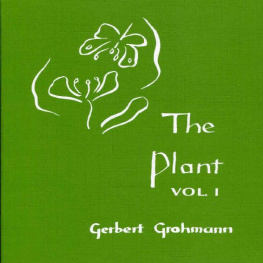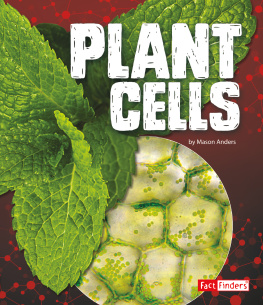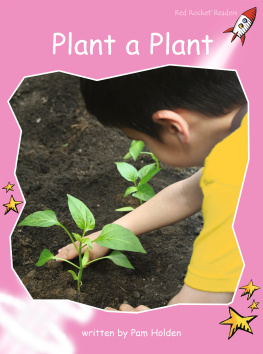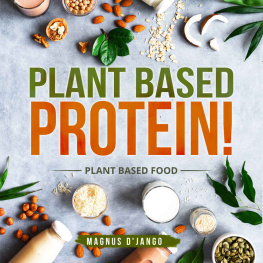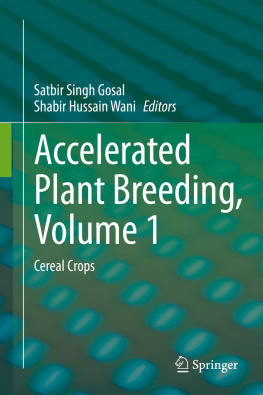Gerbert Grohmann - The Plant, Volume 1
Here you can read online Gerbert Grohmann - The Plant, Volume 1 full text of the book (entire story) in english for free. Download pdf and epub, get meaning, cover and reviews about this ebook. year: 1988, publisher: Biodynamic Farming & Gardening Association, genre: Religion. Description of the work, (preface) as well as reviews are available. Best literature library LitArk.com created for fans of good reading and offers a wide selection of genres:
Romance novel
Science fiction
Adventure
Detective
Science
History
Home and family
Prose
Art
Politics
Computer
Non-fiction
Religion
Business
Children
Humor
Choose a favorite category and find really read worthwhile books. Enjoy immersion in the world of imagination, feel the emotions of the characters or learn something new for yourself, make an fascinating discovery.
- Book:The Plant, Volume 1
- Author:
- Publisher:Biodynamic Farming & Gardening Association
- Genre:
- Year:1988
- Rating:5 / 5
- Favourites:Add to favourites
- Your mark:
- 100
- 1
- 2
- 3
- 4
- 5
The Plant, Volume 1: summary, description and annotation
We offer to read an annotation, description, summary or preface (depends on what the author of the book "The Plant, Volume 1" wrote himself). If you haven't found the necessary information about the book — write in the comments, we will try to find it.
The Plant, Volume 1 — read online for free the complete book (whole text) full work
Below is the text of the book, divided by pages. System saving the place of the last page read, allows you to conveniently read the book "The Plant, Volume 1" online for free, without having to search again every time where you left off. Put a bookmark, and you can go to the page where you finished reading at any time.
Font size:
Interval:
Bookmark:

First published by Rudolf Steiner Press, London 1974
Translation of the fourth edition of Die Pflanze, Erster Band, by G. Grohmann, Stuttgart, 1959. Published by permission of Verlag Freies Geistesleben, Stuttgart.
This edition published by
BIO-DYNAMIC FARMING & GARDENING ASSOC., INC.
Illustrations, execpt where otherwise stated, are original drawings or photographs by the author.
BIO-DYNAMIC LITERATURE 1989
ISBN 0 938250 23 X
Printed in U.S.A.

Gerbert Grohmann
The present book is the third edition of my first work which appeared in 1929. That little booklet was so eagerly received that a few years later, in 1933, I revised and enlarged it under the title of Botanik. During the war a new edition was required and I reverted to the original title of Die Pflanze. In the meantime the contents had so expanded that a single volume was not sufficient. The plant is a living thing and a book about it had to be living and capable of growth and transformation. So I took the section on non-flowering plants and combined it with most of the contents of my books Metamorphosen im Pflanzenreich and Bltenmetamorphosen into this volume.
The book was finished, printed and bound and ready for distribution when the unfortunate happenings in 1942 interrupted my writing activity. The whole edition was confiscated and went up in flames in Stuttgart without a single copy reaching the booksellers.
Fortunately, in spite of the obvious difficulties of printing such a work these days, it was possible to bring out a new impression, for many are waiting for the mental stimulus which can come from a study of the plant world. Besides scientists, I am thinking of such people as artists, teachers, doctors, farmers and gardeners. How many there are today who will welcome the opportunity to exercise their observation and thinking on the plant world! Our rigid hidebound times need such exercises as a medicine.
Years of study of Goethe's scientific writings and especially the researches of Rudolf Steiner, which cannot be valued too highly, were the guiding lines. But there would be no sense in writing yet another book on plants were the author not convinced that a new method of approach can convey new knowledge.
It is hoped the second volume dealing particularly with flowering plants will follow.
Finally I would like to thank all the friends who through conversations or their publications have helped me in my efforts.
October 1948
GERBERT GROHMANN
Dr. Gerbert Grohmann (5 June 189723 July 1957) died before he could prepare this new edition of his major work Die Pflanze. His plan to extend the contentsmainly by taking in the description of further plant families and additions to the cosmological viewpoint in Volume 2could not be carried out. So the present edition is simply another impression of the 1948 one.
Grohmann wanted to do more than just teach botany. He found a new way of looking at plants, a way which leads to a living comprehension of their varied and ever changing forms and to an understanding of the laws which shape them. This book is an important contribution to the more living exploration of nature now possible on the basis of Rudolf Steiner's Anthroposophy.
The many editions, often augmented, which have appeared since 1929, bear eloquent witness both to the approval met with by Grohmann's botanical method, which takes into consideration the spiritual aspects of the plant, and to its wide impact. We hope it will continue to find such approval in the future.
Dr. F. A. Kipp
Looking at the Flowering Plant
The most characteristic part of a plant is the green leaf. In its thousand-fold variations we recognize the leaf as the primal organ which is the living link between earthly and cosmic life. Goethe's words: How would I know that this or that form was a plant were they not all designed from a single pattern? apply particularly to the green leaf. It is attached to the stem and the point from which it springs is called a node. Leaf, node and stem form the basic unit from which all plants develop.

Fig. 1.
In the axil of the leaf is the bud, and if it starts to grow it becomes a new plant, a branch, capable of carrying its own flower. The stem is a linear structure which raises the plant up towards the sun. The leaf is a plane, a surface, and with it the plant can catch the maximum light. The bud is a contraction of the plant into a point where all future possibilities lie dormant. The capacity of regenerationthe possibility of expanding and contracting and expanding once again at rhythmic intervalsis characteristic of the purely plant nature. To follow up the development of stem, node, leaf and bud means to listen in to the secrets of vegetative life. One learns how nature sets about the creation of her children, however varied be their shape. The repetition of events in fixed rhythms has its limits set at both ends of the plant. Every plant shows us that its leaves will unfold only under the life-giving light. Below the earth's surface are no green leaves; the subterranean shoots are pale and undefined in shape, while above, in the flower, the processes are so different that some of the organs cannot easily be recognized as metamorphosed leaves.
Let us first look at the root. It can take many different forms. Sometimes it is finely branched, sometimes it consists of many single strands as in bulbous plants. It can also be swollen like a turnip or drawn into a tap root like a dandelion. The root grows in the opposite direction from the shoot, thus showing its affinity to the earth. It is averse to light and seeks darkness and damp; only rarely does it appear above ground. Through its root, the plant becomes united with Mother Earth. Though each species has its characteristic root system, the differences between plants are far greater in their upper parts. Living in the soil gives roots a certain similarity of appearance.
The root has two main characteristics. First, it has great vitality and regenerative capacity, and spreads easily. When a seed germinates, it develops a radicle or rootlet before a shoot. Without connection with the soil, life in the light would not be possible. Only the finest and outermost root tips (hair roots) can perform the vital function of taking up water and soluble mineral salts. When we transplant a plant it will wilt until it has been able to renew its hair roots. The totality of the delicate root tips comprises the actual living root system. We must look at the root in a different way from that part of the plant which is above ground. The stem grows towards the sunlight vertically; the root spreads out spherically in the soil. Although it consists of single strands, it is a spherical structure. It has the same tendency as a drop of water. By contrast the stem can be seen as a living ray of sunlight reflected by the earth. The plant is terrestrial as regards its root, cosmic as regards its stem. Between these two poles stands the two-dimensional flat leaf which in its shape portrays a conflict between spherical and linear forms.
Next pageFont size:
Interval:
Bookmark:
Similar books «The Plant, Volume 1»
Look at similar books to The Plant, Volume 1. We have selected literature similar in name and meaning in the hope of providing readers with more options to find new, interesting, not yet read works.
Discussion, reviews of the book The Plant, Volume 1 and just readers' own opinions. Leave your comments, write what you think about the work, its meaning or the main characters. Specify what exactly you liked and what you didn't like, and why you think so.

